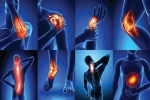Home »
Blog » Back Pain
| Stem Cell, PRP, Acupuncture in Queens & Long Island, New York
Back Pain | Stem Cell, PRP, Acupuncture in Queens & Long Island, New York
Tags: Back Pain | Posted on: 07-Dec-2020 | No of views: 8042 Chronic pain can be caused by many different factors. Often conditions that accompany normal aging may affect bones and joints in ways that cause chronic pain. Other common causes are nerve damage and injuries that fail to heal properly. Some kinds of chronic pain have numerous causes. Back pain, for example, may be caused by a single factor or any combination of these factors: Years of poor posture, Improper lifting and carrying of heavy objects, Being overweight, which puts excess strain on the back and knees, A congenital condition such as curvature of the spine, Traumatic injury, Wearing high heels, Sleeping on a poor mattress, No obvious physical cause, Ordinary aging of the spine (degenerative changes)
Read more
Tags: Back Pain | Posted on: 04-Dec-2020 | No of views: 6621 Herniated disc pain in your lower back can range from a mild ache to a shock-like pain that radiates into your leg. While most herniated discs gradually start to feel better within a few weeks, many common activities may inflame and worsen the pain. Here are a few activities to avoid. Sitting Too Much - Sitting puts more stress on your spinal discs, especially when slouching forward in a seat. To minimize pain from a herniated disc in the lumbar spine (lower back), try to stand up, move around, or lie down when possible.
Read more
Tags: Back Pain | Posted on: 02-Dec-2020 | No of views: 5981 Stem cell therapy is an innovative treatment for joint pain offered at Precision Pain Care and Rehabilitation. For many patients, stem cell therapy is a viable alternative to invasive surgery for pain relief. There is a lot of misleading information in the public sphere about what exactly stem cell therapy is, so make sure you get the facts before you decide whether or not this treatment is for you.
Read more
Tags: Back Pain | Posted on: 30-Nov-2020 | No of views: 6295 Our approach to pain management largely depends on what’s causing the pain. When it’s a byproduct of an ongoing health condition, our focus is finding a good pain management strategy to keep discomfort at a minimum. But when it’s rooted in an isolated event or injury, we can focus not only on treatment but also the prevention of chronic pain. In situations like this, it’s worth asking – can we keep acute pain from becoming chronic?
Read more
Tags: Back Pain | Posted on: 27-Nov-2020 | No of views: 6758 A neck spasm occurs when your neck muscles suddenly, involuntarily tighten. Your neck becomes painful and stiff, likely affecting the ability to turn your head. An awkward neck movement or stress-related muscle tension is often what triggers a neck spasm. Here’s a quick guide to relieving the pain. Stretch - Try to relax your spasming neck muscles. Stretching may be an effective method to loosen and soften your muscles, which tighten and seize up during a spasm.
Read more
Tags: Back Pain | Posted on: 20-Nov-2020 | No of views: 6965 Neck strains and sprains can range from mild discomfort to severe neck pain that hinders routine activities, like driving or getting dressed. Here’s how these soft tissue injuries can happen, and how to get relief. Soft Tissue Injuries in The Neck - There are numerous soft tissues that attach to the neck, including muscles, tendons, and ligaments. These soft tissues all work in tandem to support your neck and head. At the same time, they also enable movement in your neck. A neck strain or sprain occurs when one or more of these soft tissues is stretched beyond its normal range (or is injured in another way).
Read more
Tags: Back Pain | Posted on: 18-Nov-2020 | No of views: 7406 What Are Neck Spasms? A spasm is an involuntary tightening of muscle in your body. It often causes intense pain. This pain can last for minutes, hours, or days after the muscle relaxes and the spasm subsides. Spasms can happen in any part of your body where there’s a muscle, including your neck.
Read more
Tags: Back Pain | Posted on: 13-Nov-2020 | No of views: 5625 For many people living with chronic neck pain, common treatments such as medications, ice, or heating pads do not always provide enough relief. Finding the best combination of treatments for your neck pain may take some trial and error. Here are some lesser-known tips for managing neck pain that you might want to consider.
Read more
Tags: Back Pain | Posted on: 06-Nov-2020 | No of views: 5982 When you feel pain, it is due to certain chemical and electric signals that are exchanged between the site of injury and the brain. These signals are carried through your nerves. Neuropathic pain occurs when there is an injury or damage to a single nerve or group of nerves. Neuropathic pain differs from the more commonly understood nociceptive pain. Neuropathic pain occurs due to inflammation, irritation, or compression of the neural tissue. Nociceptive pain is the body’s response to painful stimuli, such as a pulled back muscle or broken bone, and does not relate to an injury of the nerve itself.
Read more
Tags: Back Pain | Posted on: 30-Oct-2020 | No of views: 9423 Daily stretching can be one of the best ways to alleviate radiating leg pain from a lumbar herniated disc. The following 3 stretches can help loosen your tight hamstring muscles for better lumbar spine support and reduce pressure on the sciatic nerve going down your leg. Just remember to stop if any exercise causes pain to worsen.
Read more
Love this Post? Spread the World






















